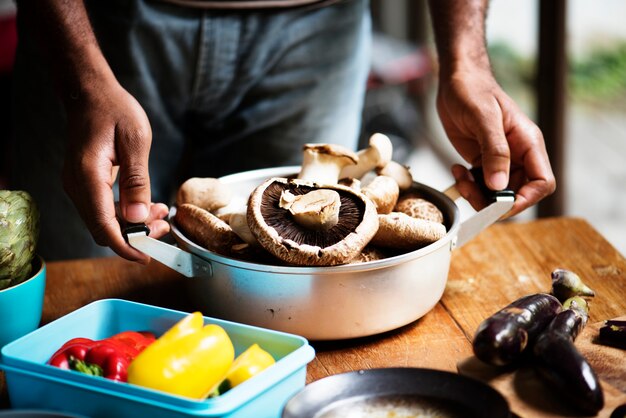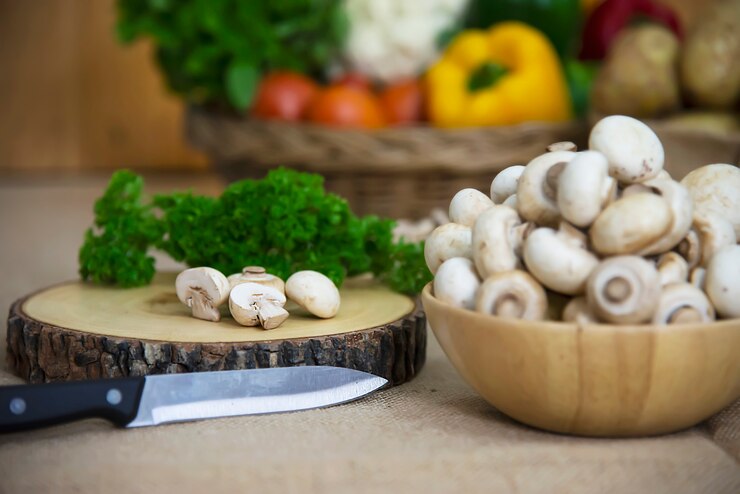Three Health Benefits of Mushrooms with Delicious Recipes to Try
These days, it seems like mushrooms are everywhere. Yes, mushrooms are popular right now. These fungi, which are sometimes mistaken for vegetables, are entirely distinct kinds of products that are either cultivated under particular circumstances to meet the huge demand from consumers today or foraged in wet woods.
Mushrooms are a veritable superfood, full of nutrients and taste, totally vegan, and beneficial to both our health and the environment. To find out more about them, continue reading.
Advantages of Nutrition
“The nutrients in mushrooms help protect against disease risk for tomorrow, and they are my go-to for optimal wellness today,” says Pam Smith, RDN, president and CEO of Shaping America’s Plate, Inc.
Mushrooms Promote Bone and Cognitive Health

“Fresh mushrooms contain the minerals and phytochemicals that can support cognitive and bone health,” according to Smith, “and are important for feeding the immune system with nutrients such as B vitamins and selenium, essential antioxidants, and in some instances, vitamin D.”
There Is a Lot of Vitamin D in Mushrooms
Even though mushrooms have numerous health advantages, Smith finds that vitamin D is the most notable. “The vitamin D present in UV-exposed mushrooms not only may help strengthen bones, but it also regulates the production of proteins your body needs to fend off bacterial and viral infections,” according to her. “What sets mushrooms apart is that they are the only item in the produce section that includes vitamin D. Look for mushrooms that have been treated to UV radiation for an additional vitamin D boost. (Alternatively, before eating, you might let your mushrooms sit in the sun for fifteen minutes.)
Mushrooms Regulate the Nervous and Digestive Systems
Another important factor in the nutritional value of mushrooms is the combination of the B vitamins (riboflavin, niacin, and pantothenic acid). “This helps maintain healthy digestive and nervous systems, as well as healthy skin and hormonal balance,” explains Smith. “They also help to maintain optimum weight and regulate cholesterol and blood sugar levels, energy, and moods.”
You’re in for some nourishment, whether you like enoki, portobello, or buttons!
“All mushrooms are nutrient-rich, so you can reap benefits by choosing whatever is available at your local grocery store, fits into your budget, and makes the most sense with your recipes,” Smith explains. “Just adding mushrooms to anything makes it better for your body, better for your taste buds, and better for the planet.”
However, if you’re looking for mushrooms to maximize your nutritional intake, there are a few standouts. “Mushrooms are the only item in the produce aisle that feature immune-supporting vitamin D, and maitake mushrooms are particularly packed,” Smith writes. A cup of maitake mushrooms provides almost a day’s worth of the daily required amount of vitamin D.
More stars for mushrooms? “Just one whole portobello or four cremini (baby bellas) provide an excellent source of copper (27 percent), selenium (28 percent), and niacin (24 percent) and contain 4.3 mg of ergothioneine,” Smith explains.
“My goal is to eat a variety of mushrooms every day—white buttons, creminis, portobellos, shiitake, maitake, beech, oyster, and lion’s mane when available—in a variety of dishes,” Smith explains. “From earthy maitakes and rich, meaty portobellos to savory shiitakes, there are a ton of intriguing mushroom tastes and textures to sample. Whether grilled, roasted, sautéed, stir-fried, or mixed utilizing a culinary method known as “The Blend,” mushrooms are a delectable way to enhance taste.
The Blend: What Is It?
To include fresh mushrooms in your cuisine, you must first chop or mince them to the consistency of minced meat and then mix them in with the beef, poultry, fish, or plant proteins. Make spaghetti sauce, chili, lamb, taco meat, meatloaf, burgers, or anything else you would normally prepare with ground protein with this method.
Adding mushrooms to ground beef or chicken is a terrific method to save money on meat in addition to the nutritional benefit. “The umami from mushrooms combines with other ingredients to enhance the taste, juiciness, and even meatiness of menu items. This may lower your meals’ overall fat, calorie, and salt content,” says Smith.
“What’s interesting about mushrooms is that they contain the same nutrient content whether raw or cooked,” Smith explains. “Roasting or grilling mushrooms with high heat and little fat or water develops savory caramelization, making them even more flavorful and bringing more umami to your dishes.”
Choosing Mushrooms
When choosing mushrooms, look for ones that are solid and have a smooth, fresh look. The mushroom’s surfaces should be plump and dry without being completely dry. A spokesman for The Mushroom Council said that a mushroom with an open veil and exposed gills has a deeper taste than one with a closed veil beneath the mushroom cap.
Keeping Mushrooms
Mushrooms should be kept in their original packaging or in a permeable paper bag to extend their shelf life. Certain mushrooms may be stored in the fridge for up to a week. If they begin to smell like ammonia or if their surface becomes wet and mushy, throw them out. Sautéed mushrooms may be stored in the freezer for up to a month, but fresh mushrooms should never be frozen.
Cleaning Mushrooms
Use your fingers or a moist paper towel to brush off any debris, such as dirt, from the mushrooms. You can also rinse them under running water for a short while and use a paper towel to pat dry. Before cooking, clip any tough mushroom stems. Although the stem is usually completely edible, shiitakes should have their stems removed before usage. The gills on portobellos are excellent for taste and marinade absorption, but you may remove them if you’d prefer.
Recipes for Mushrooms
It’s time for some recipes that include mushrooms now that you are aware of their health advantages as well as how to prepare, preserve, and clean them.
Roasted Mushrooms with Crispiness
You may not want to eat another one after tasting a fried mushroom. You can use this as a topping or as a side dish with pasta, meats, or even potato recipes. Obtain the recipe.
Tofu and Mushroom Larb
This spicy Thai salad, which celebrates mushrooms in all their wonderful textural glory, is sure to become a weeknight staple. Is it Meatless Monday yet?
Creamy Chicken and Mushroom Pasta
A comfort dish laden with mushrooms, this pasta may not specifically seem super-healthy, but because it offers mushroom’s nutritional benefits alongside a rich pasta, it nets out, right? Right.
Crispy Mushroom Reuben Sandwiches
If you’re looking for fun ways to swap mushrooms for meat, this crisp, gooey deli-style sandwich is a great place to start.
Tortellini Mushroom Soup
Store-bought tortellini gets a major glow in this homemade soup recipe with a few shortcuts. Feel free to add extra mushrooms to make it even more mushroomy!
Mushroom White Pizza
Make pizza night even better with one of the healthiest vegetable toppings out there. With a store-bought crust, it’s faster than takeout.

